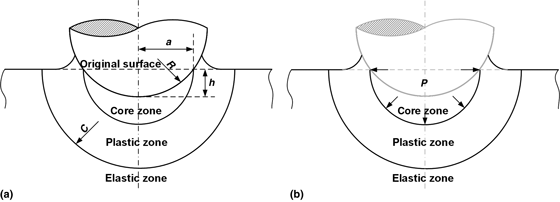Article contents
Relationships between the work recovery ratio of indentation and plastic parameters for instrumented spherical indentation
Published online by Cambridge University Press: 23 March 2015
Abstract

This paper aims to obtain an analytical expression for the ratio of unloading work of indentation (Wu) to total loading work of indentation (Wt) (work recovery ratio of indentation) in instrumented spherical indentation. The expanding cavity model and Lamé solution are used. Three typical stress–strain relations (elastic-perfectly plastic, linear hardening, and power-law hardening) are analyzed. The results of finite-element method coincide with the expressions. The expressions show that the work recovery ratio of indentation is just related to plastic parameters. Furthermore, elastic work (We) are obtained, and it is proved that We should be distinguished from Wu in spherical indentation.
- Type
- Research Letters
- Information
- Copyright
- Copyright © Materials Research Society 2015
References
- 6
- Cited by




